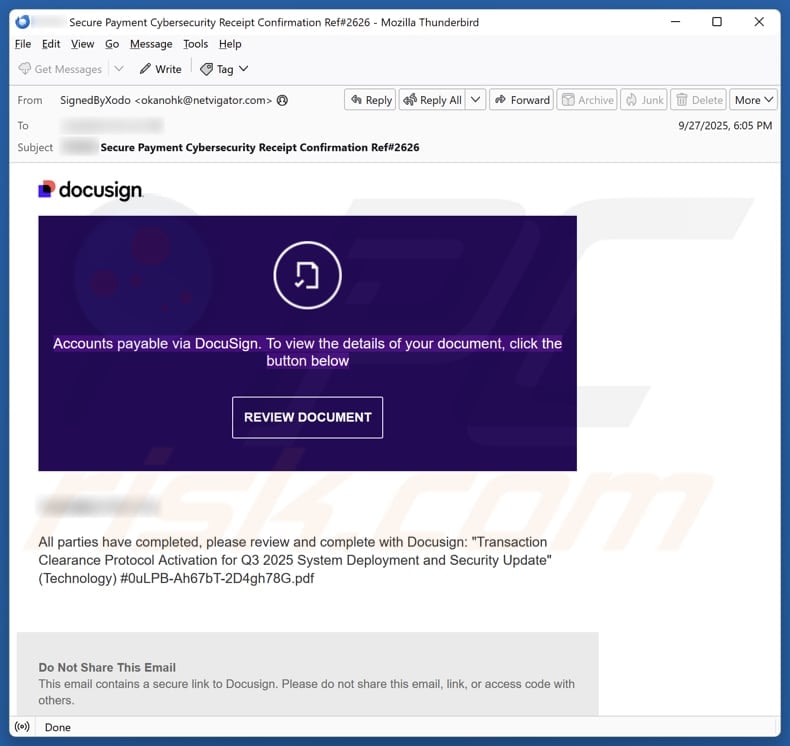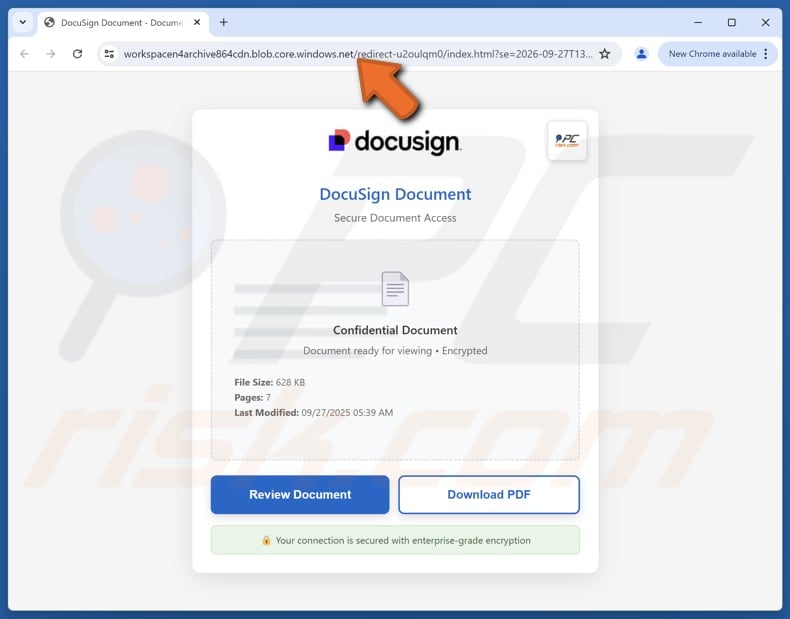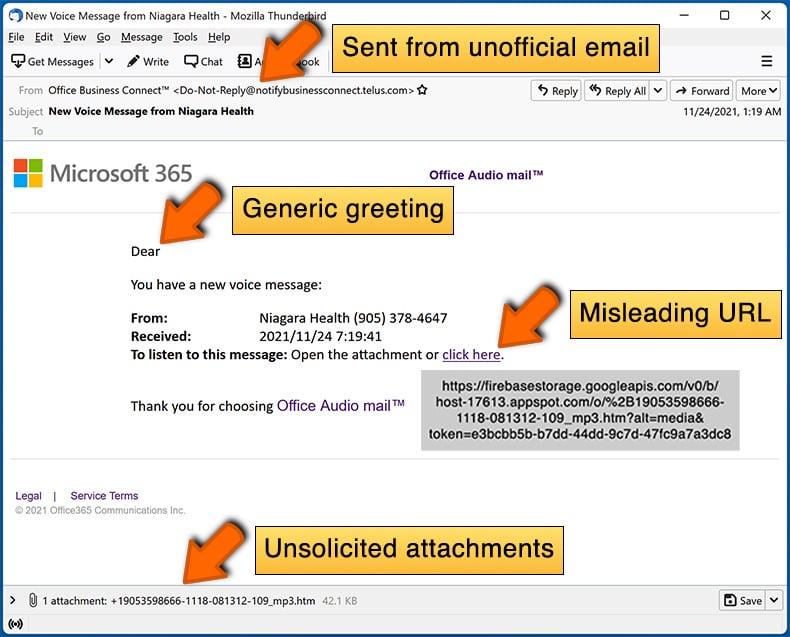How to spot scams like "Accounts Payable Via DocuSign"
Phishing/ScamAlso Known As: Accounts Payable Via DocuSign phishing email
Get free scan and check if your device is infected.
Remove it nowTo use full-featured product, you have to purchase a license for Combo Cleaner. Seven days free trial available. Combo Cleaner is owned and operated by RCS LT, the parent company of PCRisk.com.
What kind of scam is "Accounts Payable Via DocuSign"?
Our team has examined the email and found that it contains a fake receipt confirmation with links to a phishing website. The fraudsters behind this scam email seek to trick recipients into disclosing personal information. Emails of this type should be ignored to avoid account hijacking, monetary loss, or other issues.

More about the "Accounts Payable Via DocuSign" scam email
The email appears to come from DocuSign and claims to be a secure payment or cybersecurity receipt confirmation with a reference number. It instructs the recipient to review and complete a document related to a transaction clearance protocol for a system deployment and security update.
The email also warns the recipient not to share it with others and provides an "alternate method" to access the document through DocuSign using a security code. It also encourages downloading the DocuSign app and contacting the sender directly.
The link (button) in this scam email is labeled "REVIEW DOCUMENT". It leads to a fake document (named "Confidential Document") where "Review Document" and "Download PDF" options are provided. Interacting with them directs recipients to a fake login website designed to steal login credentials.
Once credentials are stolen, attackers can use them to access the victim's banking, gaming, social media, email, or other accounts. Accessed accounts can be used to send scam emails to others, harvest personal information, distribute malware, make fraudulent purchases, and more.
Therefore, recipients should always examine emails before opening links and (or) entering personal information.
| Name | Accounts Payable Via DocuSign Email Scam |
| Threat Type | Phishing, Scam, Social Engineering, Fraud |
| Fake Claim | The recipient has to review and complete the document |
| Disguise | Secure payment or cybersecurity receipt confirmation |
| Symptoms | Unauthorized online purchases, changed online account passwords, identity theft, illegal access of the computer. |
| Distribution methods | Deceptive emails, rogue online pop-up ads, search engine poisoning techniques, misspelled domains. |
| Damage | Loss of sensitive private information, monetary loss, identity theft. |
| Malware Removal (Windows) |
To eliminate possible malware infections, scan your computer with legitimate antivirus software. Our security researchers recommend using Combo Cleaner. Download Combo CleanerTo use full-featured product, you have to purchase a license for Combo Cleaner. 7 days free trial available. Combo Cleaner is owned and operated by RCS LT, the parent company of PCRisk.com. |
Conclusion
This email is a phishing attempt that impersonates DocuSign to trick recipients into visiting a fake website and revealing their login credentials. Stolen credentials can be used to access financial, social, or email accounts, leading to fraud, identity theft, and further attacks.
Sometimes, emails like this can be used to deliver malware. Overall, recipients should carefully verify emails before clicking links (or attachments) or entering any personal information. Examples of similar scams are "Insufficient Storage Space", "WeTransfer - Received Transfer Expired", and "System Has Flagged Messages Due To Security Violations".
How do spam campaigns infect computers?
Cybercriminals often spread malware through email attachments. They attach malicious MS Office files, PDFs, scripts, executables, compressed files (e.g., ZIP or RAR), etc. Opening these files or enabling features like macros can trigger the malware/cause the infection.
Emails used to deliver malware can also contain links to fake or compromised websites that either automatically download malware or deceive users into downloading and running malicious programs.
How to avoid installation of malware?
Always scrutinize emails or messages from unknown senders, especially if they seem irrelevant or suspicious. Do not open attachments or click links in such emails (or other types of messages of this kind). Keep your devices protected with trusted antivirus software. Run regular system scans, and ensure your operating system and applications are up to date.
Exercise caution on unfamiliar websites: ignore ads and pop-ups, never allow notifications from untrusted sites, and only download software from official websites or reputable app stores.
Text presented in the "Accounts Payable Via DocuSign" email letter:
Subject: ******** Secure Payment Cybersecurity Receipt Confirmation Ref#2626
DocuSign
Accounts payable via DocuSign. To view the details of your document, click the button below
REVIEW DOCUMENT********
All parties have completed, please review and complete with Docusign: "Transaction Clearance Protocol Activation for Q3 2025 System Deployment and Security Update" (Technology) #0uLPB-Ah67bT-2D4gh78G.pdf
Do Not Share This Email
This email contains a secure link to Docusign. Please do not share this email, link, or access code with others.Alternate Signing Method
Visit Docusign.com, click 'Access Documents', and enter the security code:
7B73562041C84C9596C6AB71AC759A983Questions about the Document?
If you need to modify the document or have questions about the details in the document, please reach out to the sender by emailing them directly.Download the Docusign App
Deceptive website leading to a fake login site:

Instant automatic malware removal:
Manual threat removal might be a lengthy and complicated process that requires advanced IT skills. Combo Cleaner is a professional automatic malware removal tool that is recommended to get rid of malware. Download it by clicking the button below:
DOWNLOAD Combo CleanerBy downloading any software listed on this website you agree to our Privacy Policy and Terms of Use. To use full-featured product, you have to purchase a license for Combo Cleaner. 7 days free trial available. Combo Cleaner is owned and operated by RCS LT, the parent company of PCRisk.com.
Quick menu:
- What is Accounts Payable Via DocuSign phishing email?
- Types of malicious emails.
- How to spot a malicious email?
- What to do if you fell for an email scam?
Types of malicious emails:
![]() Phishing Emails
Phishing Emails
Most commonly, cybercriminals use deceptive emails to trick Internet users into giving away their sensitive private information, for example, login information for various online services, email accounts, or online banking information.
Such attacks are called phishing. In a phishing attack, cybercriminals usually send an email message with some popular service logo (for example, Microsoft, DHL, Amazon, Netflix), create urgency (wrong shipping address, expired password, etc.), and place a link which they hope their potential victims will click on.
After clicking the link presented in such email message, victims are redirected to a fake website that looks identical or extremely similar to the original one. Victims are then asked to enter their password, credit card details, or some other information that gets stolen by cybercriminals.
![]() Emails with Malicious Attachments
Emails with Malicious Attachments
Another popular attack vector is email spam with malicious attachments that infect users' computers with malware. Malicious attachments usually carry trojans that are capable of stealing passwords, banking information, and other sensitive information.
In such attacks, cybercriminals' main goal is to trick their potential victims into opening an infected email attachment. To achieve this goal, email messages usually talk about recently received invoices, faxes, or voice messages.
If a potential victim falls for the lure and opens the attachment, their computers get infected, and cybercriminals can collect a lot of sensitive information.
While it's a more complicated method to steal personal information (spam filters and antivirus programs usually detect such attempts), if successful, cybercriminals can get a much wider array of data and can collect information for a long period of time.
![]() Sextortion Emails
Sextortion Emails
This is a type of phishing. In this case, users receive an email claiming that a cybercriminal could access the webcam of the potential victim and has a video recording of one's masturbation.
To get rid of the video, victims are asked to pay a ransom (usually using Bitcoin or another cryptocurrency). Nevertheless, all of these claims are false - users who receive such emails should ignore and delete them.
How to spot a malicious email?
While cyber criminals try to make their lure emails look trustworthy, here are some things that you should look for when trying to spot a phishing email:
- Check the sender's ("from") email address: Hover your mouse over the "from" address and check if it's legitimate. For example, if you received an email from Microsoft, be sure to check if the email address is @microsoft.com and not something suspicious like @m1crosoft.com, @microsfot.com, @account-security-noreply.com, etc.
- Check for generic greetings: If the greeting in the email is "Dear user", "Dear @youremail.com", "Dear valued customer", this should raise suspiciousness. Most commonly, companies call you by your name. Lack of this information could signal a phishing attempt.
- Check the links in the email: Hover your mouse over the link presented in the email, if the link that appears seems suspicious, don't click it. For example, if you received an email from Microsoft and the link in the email shows that it will go to firebasestorage.googleapis.com/v0... you shouldn't trust it. It's best not to click any links in the emails but to visit the company website that sent you the email in the first place.
- Don't blindly trust email attachments: Most commonly, legitimate companies will ask you to log in to their website and to view any documents there; if you received an email with an attachment, it's a good idea to scan it with an antivirus application. Infected email attachments are a common attack vector used by cybercriminals.
To minimise the risk of opening phishing and malicious emails we recommend using Combo Cleaner Antivirus for Windows.
Example of a spam email:

What to do if you fell for an email scam?
- If you clicked on a link in a phishing email and entered your password - be sure to change your password as soon as possible. Usually, cybercriminals collect stolen credentials and then sell them to other groups that use them for malicious purposes. If you change your password in a timely manner, there's a chance that criminals won't have enough time to do any damage.
- If you entered your credit card information - contact your bank as soon as possible and explain the situation. There's a good chance that you will need to cancel your compromised credit card and get a new one.
- If you see any signs of identity theft - you should immediately contact the Federal Trade Commission. This institution will collect information about your situation and create a personal recovery plan.
- If you opened a malicious attachment - your computer is probably infected, you should scan it with a reputable antivirus application. For this purpose, we recommend using Combo Cleaner Antivirus for Windows.
- Help other Internet users - report phishing emails to Anti-Phishing Working Group, FBI’s Internet Crime Complaint Center, National Fraud Information Center and U.S. Department of Justice.
Frequently Asked Questions (FAQ)
Why did I receive this email?
Your email address was likely acquired from a data breach or a fraudulent or compromised website. It is important to note that scammers often send the same message to all addresses, meaning these emails are not personal/targeted.
I have provided my personal information when tricked by this email, what should I do?
Immediately change all passwords if any login information was shared. If sensitive personal data such as credit card numbers or identification details was provided, notify the authorities.
I have downloaded and opened a malicious file attached to an email, is my computer infected?
Computers typically get infected when users interact with malicious files. For instance, when users open harmful executables or enable macros in infected MS Office documents. Whether a computer becomes infected immediately depends on the type of file that was opened.
I have read the email but did not open the attachment, is my computer infected?
Viewing (opening) an email does not pose a risk. A device can be compromised only when the user clicks on harmful links or opens unsafe attachments.
Will Combo Cleaner remove malware infections that were present in email attachment?
Combo Cleaner can detect and remove most known malware. However, some advanced threats may be deeply embedded in the system, so running a full system scan is crucial.
Share:

Tomas Meskauskas
Expert security researcher, professional malware analyst
I am passionate about computer security and technology. I have an experience of over 10 years working in various companies related to computer technical issue solving and Internet security. I have been working as an author and editor for pcrisk.com since 2010. Follow me on Twitter and LinkedIn to stay informed about the latest online security threats.
PCrisk security portal is brought by a company RCS LT.
Joined forces of security researchers help educate computer users about the latest online security threats. More information about the company RCS LT.
Our malware removal guides are free. However, if you want to support us you can send us a donation.
DonatePCrisk security portal is brought by a company RCS LT.
Joined forces of security researchers help educate computer users about the latest online security threats. More information about the company RCS LT.
Our malware removal guides are free. However, if you want to support us you can send us a donation.
Donate
▼ Show Discussion